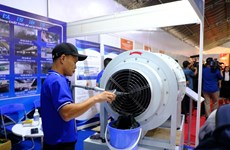Southern region needs better linkages
The Southern Key Economic Zone needed better linkages and training for
human resources, Deputy Head of Central Economic Commission Le Vinh Tan
told a workshop at Vietnam National University – HCM City
on October 23.
The Southern Key Economic Zone needed better linkages and training for
human resources, Deputy Head of Central Economic Commission Le Vinh Tan
told a workshop at Vietnam National University – HCM City
on October 23.
The area, which comprises Ho Chi Minh City and seven provinces, has succeeded in improving its infrastructure and economy since its establishment in 1998, but still needs to improve connections among provinces to exploit its competitive advantages.
He noted that the area, with 17 percent of the country's population, continues to have dynamic economic growth.
More effective linkages would help reduce infrastructure pressure in major urban centres, Phan Thanh Binh, Director of Vietnam National University – HCM City, said.
The area, which includes the provinces of Binh Duong, Tay Ninh, Binh Phuoc, Ba Ria – Vung Tau, Long An, Tien Giang and Dong Nai, accounts for only eight percent of the country's area, but produces 42 percent of national GDP and contributes 60 percent to the national budget.
The zone, the country's economic driving force, plays a leading role in international integration and economic cooperation.
The GDP growth rate in the region remained at 11 percent annually between 2001 and 2010.
In 2000, annual per capita income in the region was 11.4 million VND (542 USD) and five years later rose to 23 million VND (1,095 USD). In 2010, it was 48.6 million VND (2,314 USD) and the following year, 56.7 million VND (2,700 USD), according to HCM City Institute for Development Studies.
The high urban growth rate has contributed to the development of the economy but has also created challenges in delivering accessible housing and urban services.
Rapid growth has also led to natural resource depletion and environmental degradation.
Urban sprawl, the loss of agricultural land and the impact of climate change have all exacerbated urban development problems.
In such a context, regional planning and linkages are effective approaches and the key to ensuring optimal spatial allocation of socio-economic activities, and equal development between regions, according to experts.
Better land-use planning in the region would also help strengthen regional integration, maximise the efficiency of investments, and reduce the spatial footprints of regional growth.
Architect Ngo Quang Hung, Deputy Head of Southern Institute for Spatial Planning, predicted that by 2020 the urbanisation rate would be roughly 80 percent and by 2050, 90 percent.
During the three-day workshop, local and international experts will provide technical support for urban planning in HCM City and other provinces and cities in the Southern Key Economic Zon.-VNA
The area, which comprises Ho Chi Minh City and seven provinces, has succeeded in improving its infrastructure and economy since its establishment in 1998, but still needs to improve connections among provinces to exploit its competitive advantages.
He noted that the area, with 17 percent of the country's population, continues to have dynamic economic growth.
More effective linkages would help reduce infrastructure pressure in major urban centres, Phan Thanh Binh, Director of Vietnam National University – HCM City, said.
The area, which includes the provinces of Binh Duong, Tay Ninh, Binh Phuoc, Ba Ria – Vung Tau, Long An, Tien Giang and Dong Nai, accounts for only eight percent of the country's area, but produces 42 percent of national GDP and contributes 60 percent to the national budget.
The zone, the country's economic driving force, plays a leading role in international integration and economic cooperation.
The GDP growth rate in the region remained at 11 percent annually between 2001 and 2010.
In 2000, annual per capita income in the region was 11.4 million VND (542 USD) and five years later rose to 23 million VND (1,095 USD). In 2010, it was 48.6 million VND (2,314 USD) and the following year, 56.7 million VND (2,700 USD), according to HCM City Institute for Development Studies.
The high urban growth rate has contributed to the development of the economy but has also created challenges in delivering accessible housing and urban services.
Rapid growth has also led to natural resource depletion and environmental degradation.
Urban sprawl, the loss of agricultural land and the impact of climate change have all exacerbated urban development problems.
In such a context, regional planning and linkages are effective approaches and the key to ensuring optimal spatial allocation of socio-economic activities, and equal development between regions, according to experts.
Better land-use planning in the region would also help strengthen regional integration, maximise the efficiency of investments, and reduce the spatial footprints of regional growth.
Architect Ngo Quang Hung, Deputy Head of Southern Institute for Spatial Planning, predicted that by 2020 the urbanisation rate would be roughly 80 percent and by 2050, 90 percent.
During the three-day workshop, local and international experts will provide technical support for urban planning in HCM City and other provinces and cities in the Southern Key Economic Zon.-VNA













